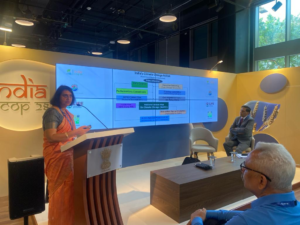Physical Address
23,24,25 & 26, 2nd Floor, Software Technology Park India, Opp: Garware Stadium,MIDC, Chikalthana, Aurangabad, Maharashtra – 431001 India
Physical Address
23,24,25 & 26, 2nd Floor, Software Technology Park India, Opp: Garware Stadium,MIDC, Chikalthana, Aurangabad, Maharashtra – 431001 India

By Aayushi Sharma
The India pavilion at the COP28 climate summit had comprehensive conversations on the extensive effects of climate change in the Himalayan area. By highlighting the significance of creating mountain communities that are resilient and environmentally sustainable, participants examined ways to reduce vulnerability for promoting “Climate Resilient Development in the Indian Himalayan Region.”
Delegates at COP28 discussed India’s current climate change measures, emphasizing the pressing need for quick action in the face of growing climate concerns.
India emphasized several essential points, including:
Indian Himalayan Initiatives
The Indian government’s Ministry of Environment, Forests, and Climate Change (Moefcc) has led several programs to protect and develop the Indian Himalayan Region (IHR). Key concerns about the preservation, development, and sustainable management of natural resources in the IHR are the main emphasis of the Central Sector Grant-in-aid Scheme on the National Mission on Himalayan Studies.
The Department of Science and Technology has also actively assisted the Himalayan Environmental Studies and Conservation Organisation to restore the Himalayas’ health by incorporating research into conservation initiatives.
Improved knowledge of the connections between climate change and the Himalayan environment is essential for more successful adaptation, and this is achieved through the National Mission for Sustaining the Himalayan Environment (NMSHE), which was established as part of the National Action Plan on Climate Change (NAPCC).
As a division of NMSHE, the State Climate Change Centres in the Himalayan States and UTs concentrate on training and capacity building for climate change adaptation planning, public awareness campaigns, and climate vulnerability assessments.
In addition, NMSHE works to create and implement cutting-edge techniques for building an extensive database and evaluating the condition of the Himalayan ecosystem, especially the glaciers. The goal of the Himalayan region’s climate vulnerability and risk assessment is to determine the threats and vulnerabilities that climate change poses to the Himalayas.
Dr. Anita Gupta, Head of the Climate Change and Clean Energy Division of the Department of Science and Technology, led the two sessions at the COP28 side event. She informed the global audience about India’s climate change initiatives. She emphasized the need for immediate action in light of the worsening effects of climate change.
References: